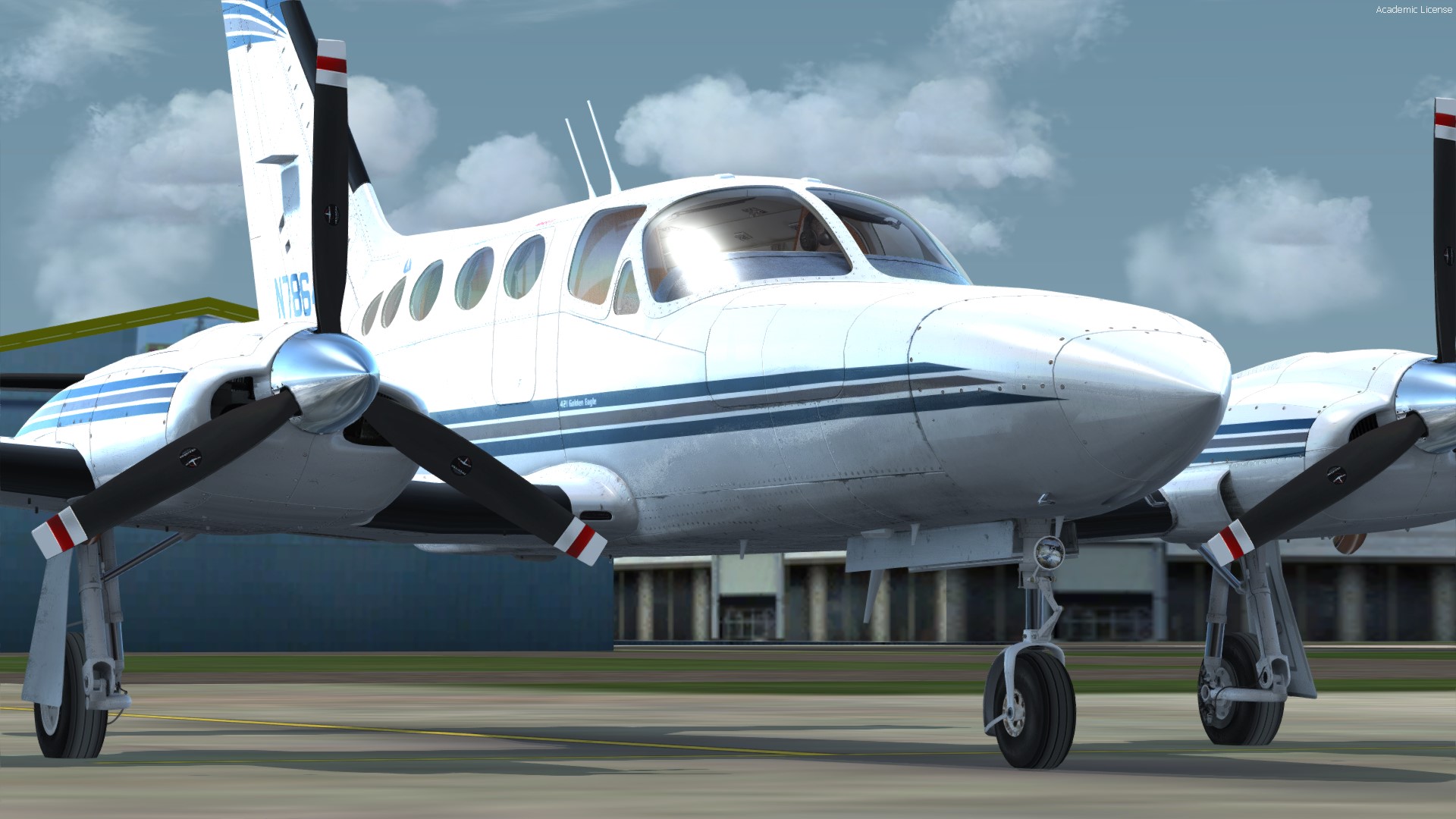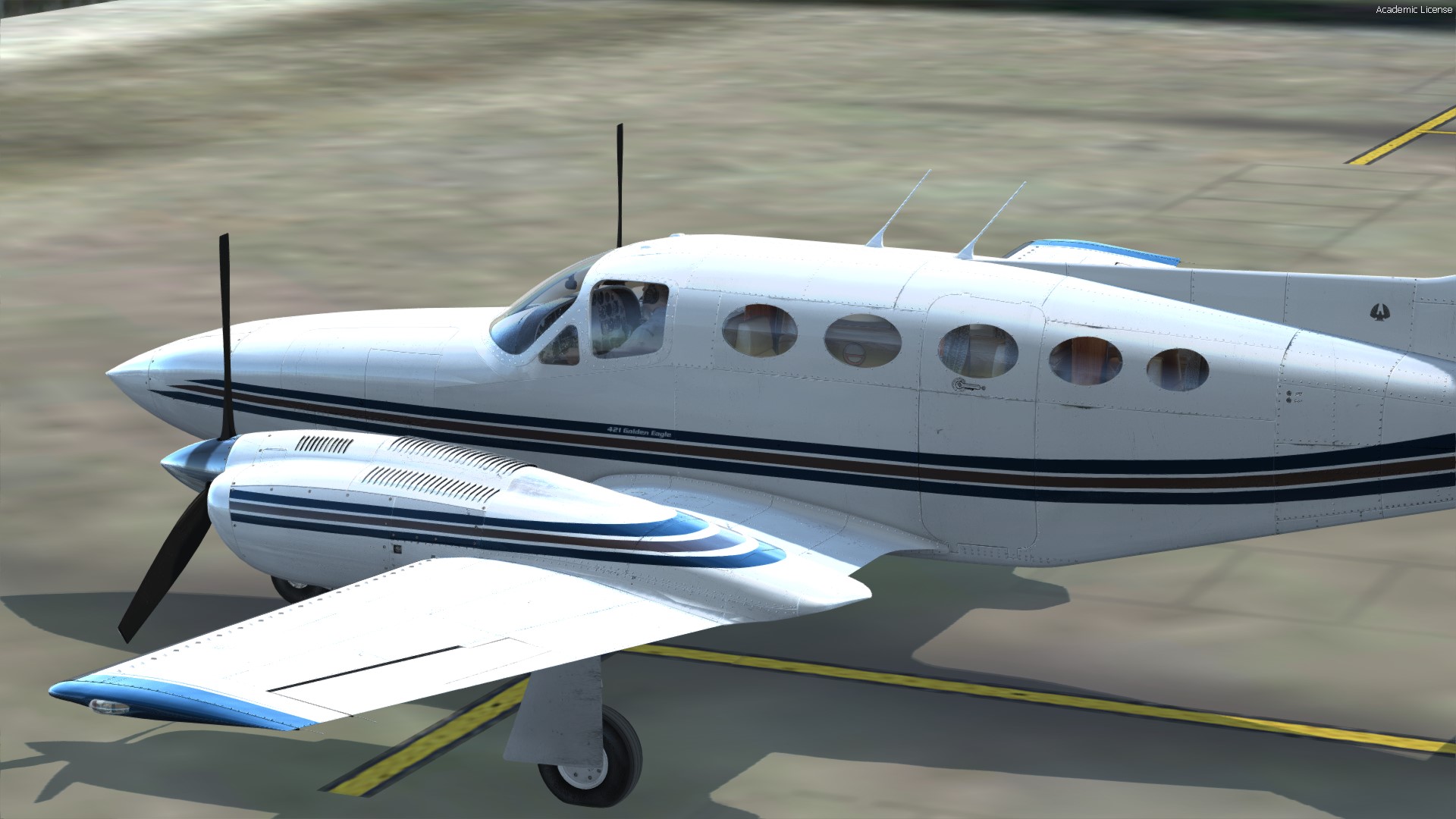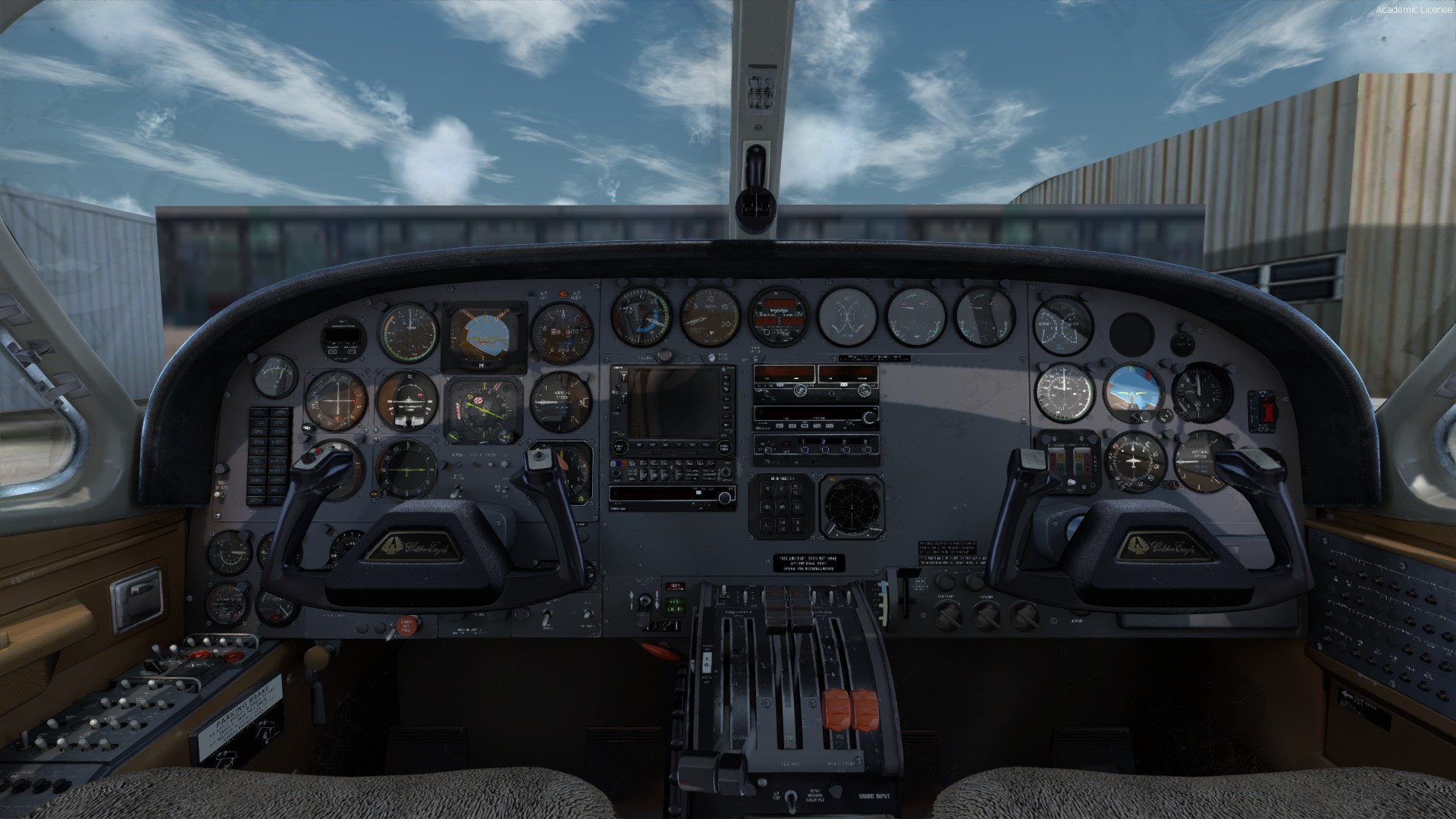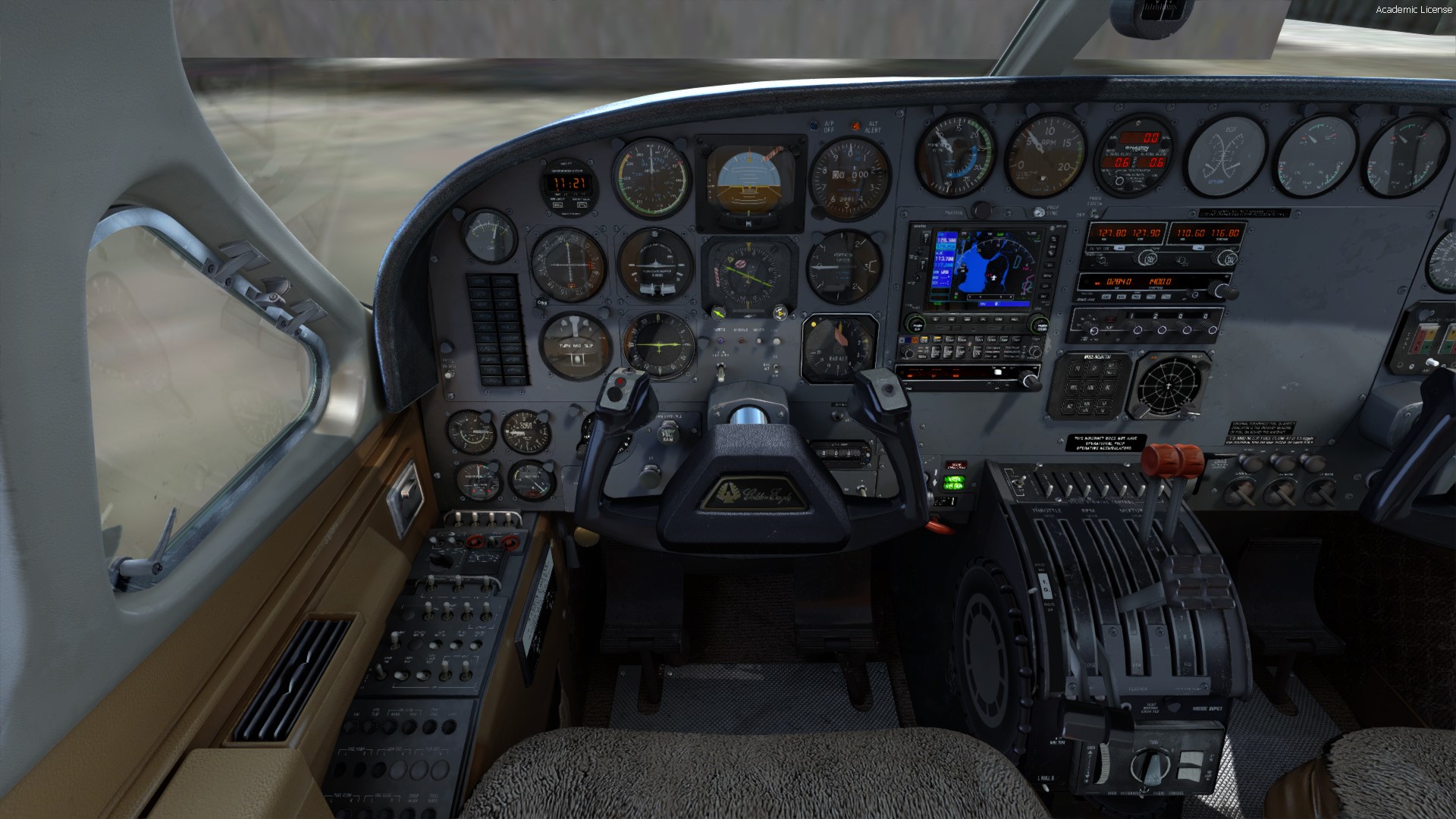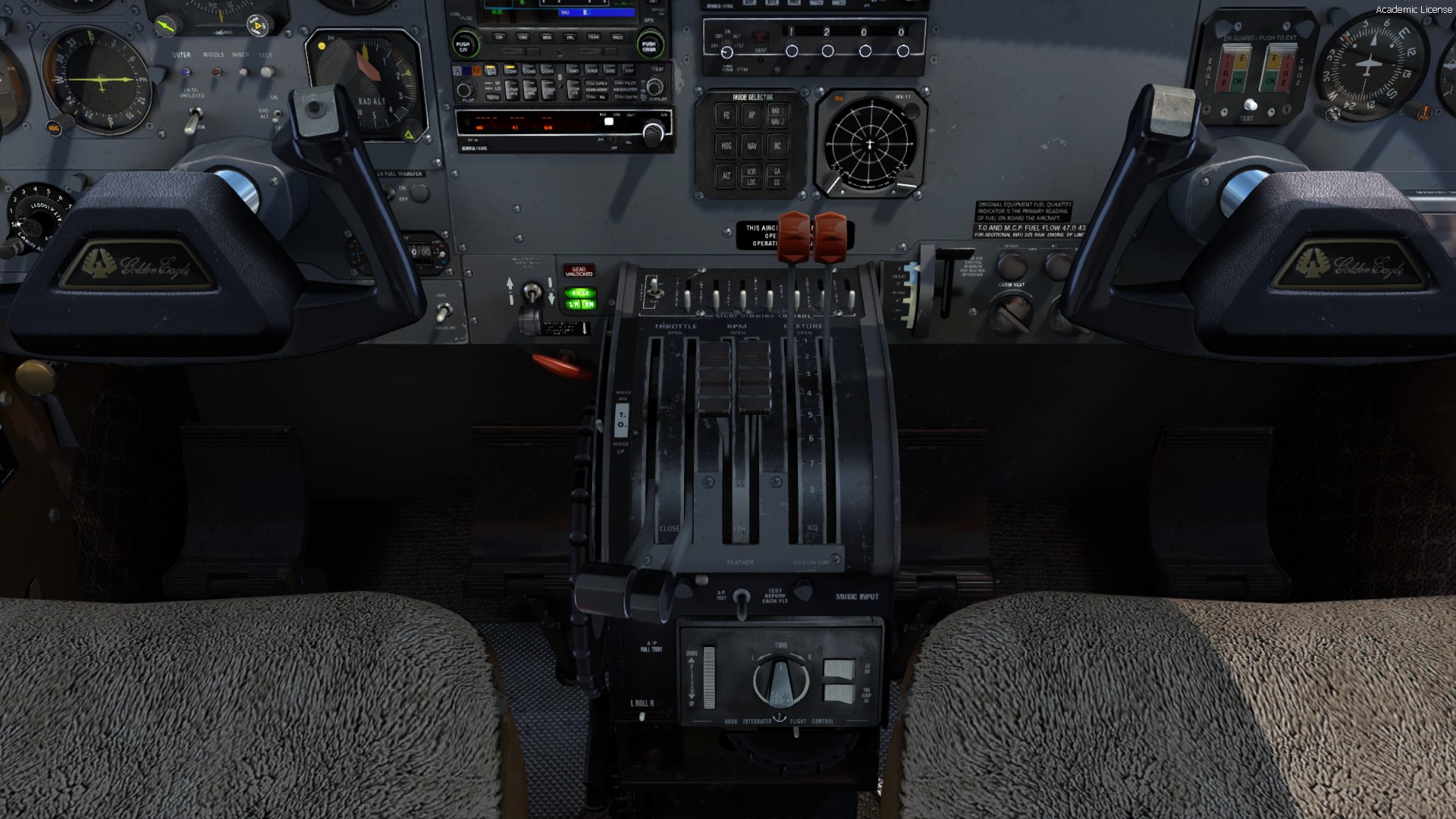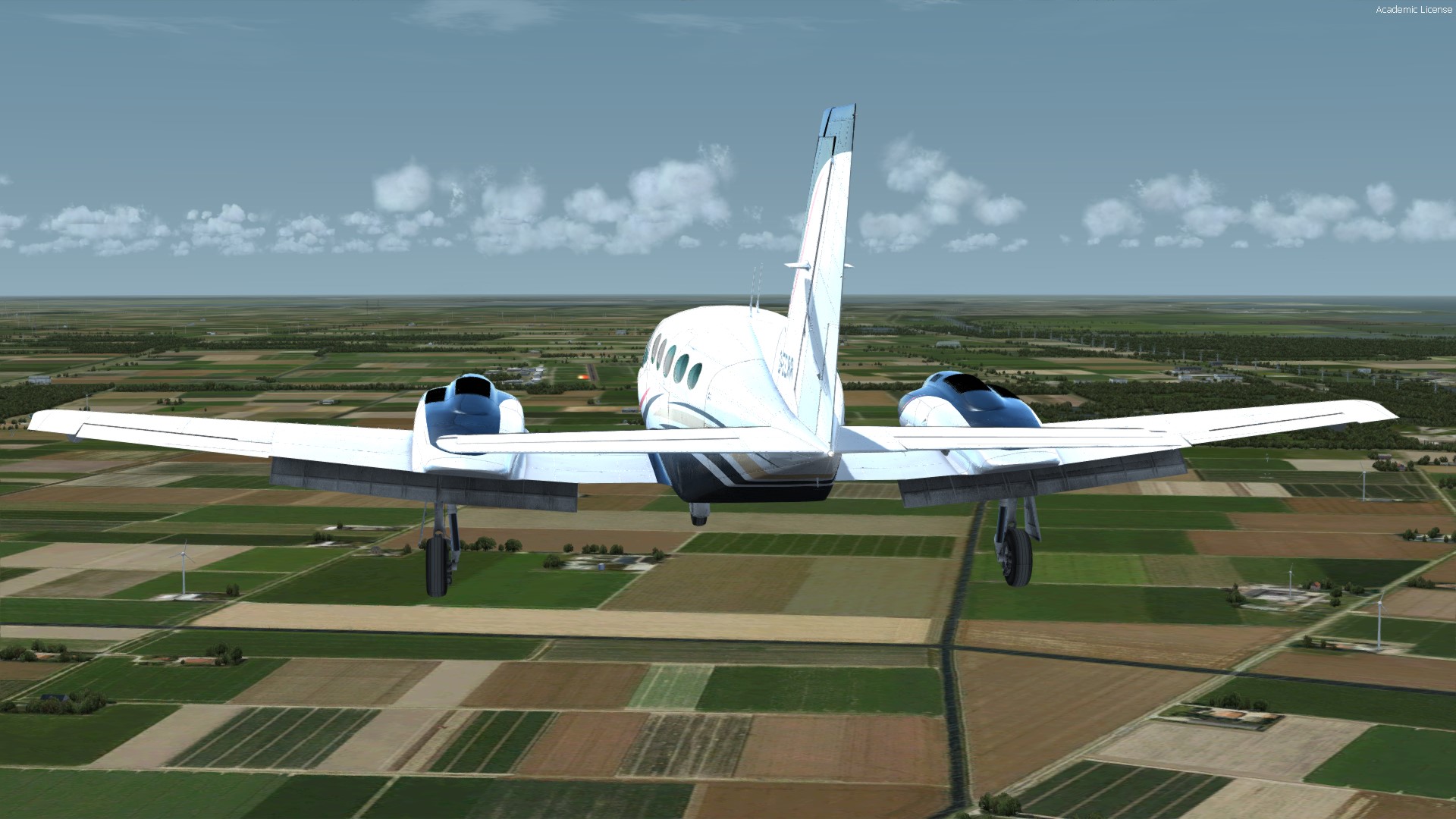Introduction
It is not until you start researching about Cessna that you actually realise how extensive their aircraft range has been over the years. This is not surprising for the world’s most prolific producer of general aviation aircraft, but nonetheless, it is easy to lose sight of this fact until you delve into the production history of the company. Cessna’s twin engine production line has produced some great models, some well known classics, such as the Cessna 310, and yet some others which have existed in the shadows of their more well known stable mates. The Cessna 421C Golden Eagle was another twin engine success story for Cessna. The fastest and largest of Cessna’s twin piston engine line, the model was an immediate success with 200 being sold in its first year.
Alabeo continue a focus on developing great aircraft which are no longer in production. The Cessna 421C Golden Eagle is another such aircraft and one which has not attracted much attention as an add-on for the flight sim community. A versatile aircraft, the Cessna 421C Golden Eagle will appeal to general aviation flight simmers looking for an aircraft with great performance and handling. Alabeo have established a reputation for producing aircraft of this type and it fits nicely into their product offering.
History
The Cessna 421C Golden Eagle is a low wing, twin engine, monoplane, with a retractable, tricycle landing gear. Powered by two Continental GTSIO-520-N, six cylinder, horizontally opposed, geared, turbocharged, 375 hp (280 kW), piston engines, it is capable of seating up to seven passengers in its normal configuration. Developed in the 1960s as a pressurised version of the earlier Cessna 411, the Cessna 421 was designed for the light transport role and is the largest and fastest of Cessna's twin piston engine line. First certified on 1 May 1967, production commenced that same month. The early models featured “Stabila-Tip” fuel tanks on the wingtips, like the Cessna 310. Subsequent improvements included a fuselage stretch, wingspan increase, with a commensurate increase in service ceiling, a stretch to the nose section, fuel capacity increases, empty and gross weight increases, the introduction of wet wings with the removal of the wingtip fuel tanks, and changes to the landing gear. The final production variant, the 421C Golden Eagle, commenced production in 1976. Production ceased in 1985 after 1,901 aircraft were produced. A range of after market turboprop engine conversions were also available.
Availability and Installation
The Alabeo Cessna 421C Golden Eagle is currently available direct from Alabeo and Alabeo re-sellers as a download only product (some re-sellers also offer a master back-up CD / DVD service for a minor additional cost). It is normally priced at US$34.95, or the equivalent on currency cross rates. The download file size is 723MB and it requires 1.85GB of HDD/SSD space for installation. You are required to log in to your Alabeo account during installation to verify your purchase and the installation process is intuitive and seamless.
Model Features
The major model features of the Cessna 421C Golden Eagle include:
high quality 3D model and textures;Alabeo GNS 530 GPS unit;
Flight1 GTN 750 integration;
Reality XP GNS530 v2 integration (only for FSX);
material shines and reflections, and volumetric side view prop effect;
gauges reflections, knob click sounds, windows scratches, and blades shines; and
cold and dark start option.
Visual Appearance
General Overview. The Cessna 421C Golden Eagle, not surprisingly, bears striking similarities with other Cessna twin engine models. It is distinguished by the distinctive elongated nose section, oval windows, and similar empennage design found on other Cessna models. An imposing aircraft in the Cessna fleet, the size of the aircraft gives the impression of a comfortable interior befitting its role as a light transport aircraft. The overall modelling of the aircraft is excellent and fully captures the design and features of the real world aircraft.
Exterior. The elongated nose, leads into a cockpit window layout similar to other Cessna twin engine models. The fuselage is again, typical, and has a distinctive box shape to it with the characteristic oval cabin windows. The wings vary on the 421C variant in that they do not have the familiar wingtip fuel tanks as seen on the earlier 421 variants, and Cessna 310, 340, and other models. The engines protrude well forward of the wing mounts and appear overly large for the aircraft’s wing span, and they certainly give the impression that they are more than adequate in making the Cessna 421C the fastest of Cessna’s twin piston engine models. Alabeo’s external modelling is of a high quality, displaying great detail and the features of the aircraft.
Interior. The interior of the Cessna 421C Golden Eagle is spacious and comfortable and Alabeo have modelled the interior on a standard configuration with a club lounge seating layout. Entrance to the cabin is via a door on the rear left side of the fuselage, behind the wing. The large oval cabin windows provide a very large, open feel to the cabin, and afford excellent visibility from all passenger seats.
Flight Instruments, Avionics, and Aircraft Systems. The cockpit of the Cessna 421C Golden Eagle is characteristic of the aircraft and the production era. The primary flight instruments are all analogue and are supplemented by the addition of a Garmin GNS 530 GPS unit. The cockpit panel displays evidence of wear marks, and the quality of the textures and rendering for the cockpit and instruments are of an excellent quality. Various additional cockpit views provide a more focused and detailed view of the selected panel areas and controls.
Lighting, Animations, and Sounds. The night lighting effect in the cockpit provides an excellent representation of the night lighting in the real world aircraft, however there didn’t appear to be any way of isolating the cockpit panel lighting from the overhead dome and cabin lighting. The Cessna 421C Golden Eagle includes the typical range of animations and static elements you would expect for such an aircraft. The engine sounds are a very good representation of the Continental GTSIO-520 engines, producing a consistent sound throughout the power range and the engine sounds also provide good stereo separation in both the internal and external views.
Models and Liveries. The 421C Golden Eagle is provided in a single model with five individual liveries (a selection showing below). There is also a blank texture provided for aircraft painting enthusiasts. Displaying high quality, the surface textures, reflections, and shadings, give each aircraft a very good appearance. Additionally, fuselage weathering and wear and tear marks, and dirt, exhaust, oil, and grease stains, add to the realistic presentation of the aircraft.
Summary and Variations. With the exception of the noted lighting issue, no other major issues were noted. The Cessna 421C Golden Eagle exhibits excellent modelling and texture quality with both the exterior and interior renditions being detailed and accurate, providing a faithful representation of the real world aircraft. Any other noted visual variations were minor and are considered to be related to real world production variations or a degree of artistic licence on the part of the developer. Any noted issues and variations with cockpit functions and operation were considered minor and / or in the interests of simplifying the function for practical flight simulator use.
General Characteristics and Performance Specifications
The general characteristics and performance specifications for the Cessna 421C Golden Eagle are provided in the table. This is based on data from the official Cessna 421C Golden Eagle Pilot Operating Handbook, data provided by Alabeo, and general research sources. Some of this data varies between sources and also may be an approximation due to variances in data and the specific aircraft modelled by Alabeo.
General Characteristics
| Crew | One/Two |
| Passenger Capacity | Six passengers |
| Length | 36 ft 9.6 in (11.09 m) |
| Wingspan | 41 ft 1.5 in (12.53 m) |
| Height | 11 ft 5.4 in (6.62 m) |
| Empty Weight | 4,501 lb (2,041 kg) |
| Fuel Capacity | 221 US gal (837 l) |
| Maximum Take-Off Weight (MTOW) | 7,450 lb (3,379 kg) |
| Power Plant | 2 x Continental GTSIO-520-N, six cylinder, horizontally opposed, geared, turbocharged, piston engine, 375 hp (280 kW) |
Performance Specifications
| Maximum Speed | 256 kts (295 mph, 475 km/h) at 20,000 ft |
| Cruise Speed | 240 kts (276 mph, 278 km/h) at 25,000 ft, 75% power |
| Stall Speed | 77 kts (89 mph, 143 km/h) full flaps, gear down, engine at idle |
| Range | 1,487 nm (1,712 mi, 2,755 km) |
| Service Ceiling | 30,200 ft (9,205 m) |
| Rate of Climb | 1,940 ft/min (591 m/min) |
Flight Performance
A specific Test Flight was conducted to test the flight performance of the Cessna 421C Golden Eagle. The flight was conducted in clear weather with a full fuel load and the aircraft at maximum take-off weight (MTOW). A cruise altitude of FL200 was adopted and the route distance was particularly chosen to provide a basis upon which to test the range characteristics of the aircraft.
The aircraft is easy to taxi and steer on the ground. With trim set to the take-off position, aircraft rotation occurred at approximately 85 KIAS. The twin Continental GTSIO-520-N engines provide the Cessna 421C Golden Eagle with a good power to weight ratio, enabling the aircraft to maintain a steady rate of climb of approximately 1,900 ft/min at 100 KIAS. With the necessary power and and trim adjustments, the aircraft quickly climbed to the cruise altitude of FL200 with ease, demonstrating the great performance of the twin GTSIO-520-N engines.
During cruise, a 60% cruise power setting was established with a manifold pressure setting of 29.0 inHg and an RPM setting of 1,800 RPM. With this cruise setting, the aircraft trims out and produces a ground speed of approximately 209 kts. These performance figures are reasonably consistent with the published performance data and characteristics of the aircraft. The Test Flight confirms the modelling of the aircraft for speed performance to be what would reasonably be expected of this aircraft.
Configured for landing, with full flaps, and trimmed for a descent rate of approximately 500 ft/min, the aircraft’s approach speed was approximately 100 KIAS and it touched down at approximately 85 KIAS, with a landing roll-out comparable with the specifications for the aircraft.
In testing the accuracy of the instruments, based on the measured Test Flight, the speed indications on the airspeed indicator, were consistent with the averages measured. Additionally, when establishing a set rate of climb on the vertical speed indicator, the respective gain in altitude on the altimeter was achieved within the measured minute, and a standard rate turn was achieved within the measured two minute period using the turn coordinator.
The characteristics of the Cessna 421C Golden Eagle reasonably met the expectations for this aircraft. It is a sizeable aircraft and yet it is nimble and responsive to control inputs. Overall, the general handling characteristics are excellent, and the aircraft model displays a very good rendition of the flight characteristics and performance against the aircraft performance data.
Documentation
Six documents are provided in Adobe Acrobat format (.pdf) for the Alabeo Cessna 421C Golden Eagle:
Alabeo Cessna 421 Normal Procedures,
Alabeo Cessna 421 Emergency Procedures,
Alabeo Cessna 421 Performance Tables,
Alabeo Cessna 421 References,
Alabeo GNS 530 User Guide, and
Recommended Settings.
Value for Money
At US$34.95, the pricing of the Alabeo Cessna 421C Golden Eagle is consistent with their product range. However, Alabeo continue to model aircraft for the fun and enjoyment of flying and do not focus on more detail and complexity in the aircraft model. At this price point, and for the aircraft you get, it is considered that the Value for Money for the Alabeo 421C Golden Eagle is only considered reasonable.
Simulator Performance
The aircraft model performed excellently within the existing settings I have in P3D. I have most of my settings set very high and there was no need to make any adjustments. There was no discernible frame rate impact directly attributable to the Alabeo 421C Golden Eagle and P3D continued to perform smoothly.
Technical Requirements
This version of the Alabeo 421C Golden Eagle is for FSX/FSX SE/P3D only. Other specified technical requirements are as follows:
Windows 10/7/8/Vista/XP;
FSX with SP2 installed (or Acceleration Pack), FSX Steam Edition, or Prepar3D (v3/v4); and
Pentium V, 2GHz CPU or similar, 2GB RAM, 512MB graphics card, and 1.85GB available HDD space.
Review Computer Specifications
The specifications of the computer on which the review was conducted are as follows:
Intel i7 990X Extreme 3.46GHz;
NVidia GTX980 G1 Gaming, 4GB, 1228/1329MHz;
12GB, Kingston DDR3, 2000MHz, XMP T1 CL9 HyperX;
Windows 7, (64bit); and
Lockheed Martin P3D Version 4.
Additional Major Add-Ons. Active Sky for P3Dv4, Active Sky Cloud Art, SPAD.neXt, FS Global Ultimate region series, Orbx FTX Global BASE, Orbx FTX Global VECTOR, Orbx FTX Global openLC series, Orbx FTX region series, Orbx FTX airport series, and Orbx FTX Trees HD.
Conclusion
The Alabeo 421C Golden Eagle is a beautiful aircraft. Alabeo’s overall modelling of the aircraft is wonderful and they have done an excellent job of capturing the visual essence of this aircraft and its flying characteristics. The flight characteristics are exactly what you would expect and even at MTOW the aircraft climbs effortlessly. An absolute delight to fly, the Cessna 421C Golden Eagle will greatly appeal to Cessna and general aviation fans if you can overlook the marginally high price.
Verdict and Scores
Verdict
| The Alabeo 421C Golden Eagle is a marvellous aircraft with great flight characteristics and performance. |
Scores
For |
Against |
Category |
Score/10 |
|---|---|---|---|
| High quality textures. | Marginal Value for Money. | External Model | 9.5 |
| Excellent exterior and interior modelling. | Internal Model | 9.0 | |
| Marvellous engine sounds. | Sounds | 9.0 | |
| Realistic flight characteristics and handling. | Flight Characteristics (does it fly by the numbers) | 9.0 | |
| Excellent documentation. | Flight Dynamics (does it feel like what it looks like) | 9.5 | |
| Documentation | 9.0 | ||
| Value for Money | 8.0 |
Overall Score

The Alabeo 421C Golden Eagle is awarded an overall Mutley's Hangar score of 905/10, |




